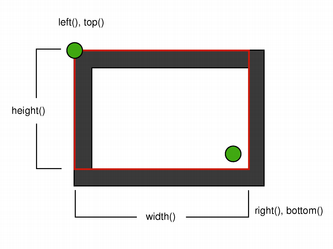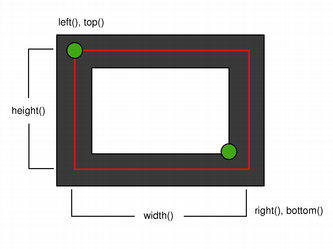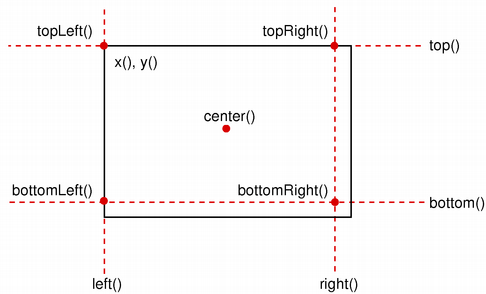QRect¶
The QRect class defines a rectangle in the plane using integer precision. More…
Synopsis¶
Functions¶
def
__add__(margins)def
__add__(margins)def
__and__(r)def
__eq__(r2)def
__iadd__(margins)def
__iand__(r)def
__ior__(r)def
__isub__(margins)def
__ne__(r2)def
__or__(r)def
__reduce__()def
__repr__()def
__sub__(rhs)def
adjust(x1, y1, x2, y2)def
adjusted(x1, y1, x2, y2)def
bottom()def
bottomLeft()def
bottomRight()def
center()def
contains(p[, proper=false])def
contains(r[, proper=false])def
contains(x, y)def
contains(x, y, proper)def
getCoords()def
getRect()def
height()def
intersected(other)def
intersects(r)def
isEmpty()def
isNull()def
isValid()def
left()def
marginsAdded(margins)def
marginsRemoved(margins)def
moveBottom(pos)def
moveBottomLeft(p)def
moveBottomRight(p)def
moveCenter(p)def
moveLeft(pos)def
moveRight(pos)def
moveTo(p)def
moveTo(x, t)def
moveTop(pos)def
moveTopLeft(p)def
moveTopRight(p)def
normalized()def
right()def
setBottom(pos)def
setBottomLeft(p)def
setBottomRight(p)def
setCoords(x1, y1, x2, y2)def
setHeight(h)def
setLeft(pos)def
setRect(x, y, w, h)def
setRight(pos)def
setSize(s)def
setTop(pos)def
setTopLeft(p)def
setTopRight(p)def
setWidth(w)def
setX(x)def
setY(y)def
size()def
top()def
topLeft()def
topRight()def
translate(dx, dy)def
translate(p)def
translated(dx, dy)def
translated(p)def
transposed()def
united(other)def
width()def
x()def
y()
Static functions¶
def
span(p1, p2)
Detailed Description¶
A rectangle is normally expressed as a top-left corner and a size. The size (width and height) of a QRect is always equivalent to the mathematical rectangle that forms the basis for its rendering.
A QRect can be constructed with a set of left, top, width and height integers, or from a QPoint and a QSize . The following code creates two identical rectangles.
r1 = QRect(100, 200, 11, 16) r2 = QRect(QPoint(100, 200), QSize(11, 16))
There is a third constructor that creates a QRect using the top-left and bottom-right coordinates, but we recommend that you avoid using it. The rationale is that for historical reasons the values returned by the bottom() and right() functions deviate from the true bottom-right corner of the rectangle.
The QRect class provides a collection of functions that return the various rectangle coordinates, and enable manipulation of these. QRect also provides functions to move the rectangle relative to the various coordinates. In addition there is a moveTo() function that moves the rectangle, leaving its top left corner at the given coordinates. Alternatively, the translate() function moves the rectangle the given offset relative to the current position, and the translated() function returns a translated copy of this rectangle.
The size() function returns the rectangle’s dimensions as a QSize . The dimensions can also be retrieved separately using the width() and height() functions. To manipulate the dimensions use the setSize() , setWidth() or setHeight() functions. Alternatively, the size can be changed by applying either of the functions setting the rectangle coordinates, for example, setBottom() or setRight() .
The contains() function tells whether a given point is inside the rectangle or not, and the intersects() function returns true if this rectangle intersects with a given rectangle. The QRect class also provides the intersected() function which returns the intersection rectangle, and the united() function which returns the rectangle that encloses the given rectangle and this:
The isEmpty() function returns true if left() > right() or top() > bottom() . Note that an empty rectangle is not valid: The isValid() function returns true if left() <= right() and top() <= bottom() . A null rectangle ( isNull() == true) on the other hand, has both width and height set to 0.
Note that due to the way QRect and QRectF are defined, an empty QRect is defined in essentially the same way as QRectF .
Finally, QRect objects can be streamed as well as compared.
Rendering¶
When using an anti-aliased painter, the boundary line of a QRect will be rendered symmetrically on both sides of the mathematical rectangle’s boundary line. But when using an aliased painter (the default) other rules apply.
Then, when rendering with a one pixel wide pen the QRect ‘s boundary line will be rendered to the right and below the mathematical rectangle’s boundary line.
When rendering with a two pixels wide pen the boundary line will be split in the middle by the mathematical rectangle. This will be the case whenever the pen is set to an even number of pixels, while rendering with a pen with an odd number of pixels, the spare pixel will be rendered to the right and below the mathematical rectangle as in the one pixel case.
Logical representation
One pixel wide pen
Two pixel wide pen
Three pixel wide pen
Coordinates¶
The QRect class provides a collection of functions that return the various rectangle coordinates, and enable manipulation of these. QRect also provides functions to move the rectangle relative to the various coordinates.
For example the left() , setLeft() and moveLeft() functions as an example: left() returns the x-coordinate of the rectangle’s left edge, setLeft() sets the left edge of the rectangle to the given x coordinate (it may change the width, but will never change the rectangle’s right edge) and moveLeft() moves the entire rectangle horizontally, leaving the rectangle’s left edge at the given x coordinate and its size unchanged.
Note that for historical reasons the values returned by the bottom() and right() functions deviate from the true bottom-right corner of the rectangle: The right() function returns ** left() + width() - 1 and the bottom() function returns ** top() + height() - 1. The same is the case for the point returned by the bottomRight() convenience function. In addition, the x and y coordinate of the topRight() and bottomLeft() functions, respectively, contain the same deviation from the true right and bottom edges.
We recommend that you use x() + width() and y() + height() to find the true bottom-right corner, and avoid right() and bottom() . Another solution is to use QRectF : The QRectF class defines a rectangle in the plane using floating point accuracy for coordinates, and the right() and bottom() functions do return the right and bottom coordinates.
It is also possible to add offsets to this rectangle’s coordinates using the adjust() function, as well as retrieve a new rectangle based on adjustments of the original one using the adjusted() function. If either of the width and height is negative, use the normalized() function to retrieve a rectangle where the corners are swapped.
In addition, QRect provides the getCoords() function which extracts the position of the rectangle’s top-left and bottom-right corner, and the getRect() function which extracts the rectangle’s top-left corner, width and height. Use the setCoords() and setRect() function to manipulate the rectangle’s coordinates and dimensions in one go.
Constraints¶
QRect is limited to the minimum and maximum values for the int type. Operations on a QRect that could potentially result in values outside this range will result in undefined behavior.
See also
QRectFQRegion
- class PySide6.QtCore.QRect¶
PySide6.QtCore.QRect(topleft, bottomright)
PySide6.QtCore.QRect(topleft, size)
PySide6.QtCore.QRect(QRect)
PySide6.QtCore.QRect(left, top, width, height)
- Parameters
width – int
left – int
bottomright –
PySide6.QtCore.QPointtopleft –
PySide6.QtCore.QPointQRect –
PySide6.QtCore.QRectsize –
PySide6.QtCore.QSizetop – int
height – int
Constructs a null rectangle.
See also
Constructs a rectangle with the given topLeft and bottomRight corners, both included.
If bottomRight is to higher and to the left of topLeft, the rectangle defined is instead non-inclusive of the corners.
Constructs a rectangle with the given topLeft corner and the given size.
See also
Constructs a rectangle with (x, y) as its top-left corner and the given width and height.
See also
- PySide6.QtCore.QRect.__reduce__()¶
- Return type
object
- PySide6.QtCore.QRect.__repr__()¶
- Return type
object
- PySide6.QtCore.QRect.adjust(x1, y1, x2, y2)¶
- Parameters
x1 – int
y1 – int
x2 – int
y2 – int
Adds dx1, dy1, dx2 and dy2 respectively to the existing coordinates of the rectangle.
See also
- PySide6.QtCore.QRect.adjusted(x1, y1, x2, y2)¶
- Parameters
x1 – int
y1 – int
x2 – int
y2 – int
- Return type
Returns a new rectangle with dx1, dy1, dx2 and dy2 added respectively to the existing coordinates of this rectangle.
See also
- PySide6.QtCore.QRect.bottom()¶
- Return type
int
Returns the y-coordinate of the rectangle’s bottom edge.
Note that for historical reasons this function returns top() + height() - 1; use y() + height() to retrieve the true y-coordinate.
See also
- PySide6.QtCore.QRect.bottomLeft()¶
- Return type
Returns the position of the rectangle’s bottom-left corner. Note that for historical reasons this function returns QPoint ( left() , top() + height() - 1).
See also
- PySide6.QtCore.QRect.bottomRight()¶
- Return type
Returns the position of the rectangle’s bottom-right corner.
Note that for historical reasons this function returns QPoint ( left() + width() -1, top() + height() - 1).
See also
- PySide6.QtCore.QRect.center()¶
- Return type
Returns the center point of the rectangle.
See also
- PySide6.QtCore.QRect.contains(r[, proper=false])¶
- Parameters
proper – bool
- Return type
bool
This is an overloaded function.
Returns true if the given rectangle is inside this rectangle. otherwise returns false. If proper is true, this function only returns true if the rectangle is entirely inside this rectangle (not on the edge).
- PySide6.QtCore.QRect.contains(x, y, proper)
- Parameters
x – int
y – int
proper – bool
- Return type
bool
This is an overloaded function.
Returns true if the point (x, y) is inside or on the edge of the rectangle, otherwise returns false. If proper is true, this function only returns true if the point is entirely inside the rectangle(not on the edge).
- PySide6.QtCore.QRect.contains(x, y)
- Parameters
x – int
y – int
- Return type
bool
This is an overloaded function.
Returns true if the point (x, y) is inside this rectangle, otherwise returns false.
- PySide6.QtCore.QRect.contains(p[, proper=false])
- Parameters
proper – bool
- Return type
bool
Returns true if the given point is inside or on the edge of the rectangle, otherwise returns false. If proper is true, this function only returns true if the given point is inside the rectangle (i.e., not on the edge).
See also
- PySide6.QtCore.QRect.getCoords()¶
Extracts the position of the rectangle’s top-left corner to *``x1`` and *``y1``, and the position of the bottom-right corner to *``x2`` and *``y2``.
See also
- PySide6.QtCore.QRect.getRect()¶
Extracts the position of the rectangle’s top-left corner to *``x`` and *``y``, and its dimensions to *``width`` and *``height``.
See also
- PySide6.QtCore.QRect.height()¶
- Return type
int
Returns the height of the rectangle.
See also
- PySide6.QtCore.QRect.intersected(other)¶
- Parameters
other –
PySide6.QtCore.QRect- Return type
Returns the intersection of this rectangle and the given rectangle. Note that r.intersected(s) is equivalent to r & s.
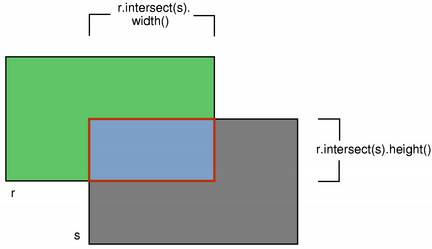
See also
intersects()united()operator&=()
- PySide6.QtCore.QRect.intersects(r)¶
- Parameters
- Return type
bool
Returns true if this rectangle intersects with the given rectangle (i.e., there is at least one pixel that is within both rectangles), otherwise returns false.
The intersection rectangle can be retrieved using the intersected() function.
See also
- PySide6.QtCore.QRect.isEmpty()¶
- Return type
bool
Returns true if the rectangle is empty, otherwise returns false.
An empty rectangle has a left() > right() or top() > bottom() . An empty rectangle is not valid (i.e., == ! isValid() ).
Use the normalized() function to retrieve a rectangle where the corners are swapped.
See also
- PySide6.QtCore.QRect.isNull()¶
- Return type
bool
Returns true if the rectangle is a null rectangle, otherwise returns false.
A null rectangle has both the width and the height set to 0 (i.e., right() == left() - 1 and bottom() == top() - 1). A null rectangle is also empty, and hence is not valid.
- PySide6.QtCore.QRect.isValid()¶
- Return type
bool
Returns true if the rectangle is valid, otherwise returns false.
A valid rectangle has a left() <= right() and top() <= bottom() . Note that non-trivial operations like intersections are not defined for invalid rectangles. A valid rectangle is not empty (i.e., == ! isEmpty() ).
See also
- PySide6.QtCore.QRect.left()¶
- Return type
int
Returns the x-coordinate of the rectangle’s left edge. Equivalent to x() .
See also
- PySide6.QtCore.QRect.marginsAdded(margins)¶
- Parameters
margins –
PySide6.QtCore.QMargins- Return type
Returns a rectangle grown by the margins.
See also
operator+=()marginsRemoved()operator-=()
- PySide6.QtCore.QRect.marginsRemoved(margins)¶
- Parameters
margins –
PySide6.QtCore.QMargins- Return type
Removes the margins from the rectangle, shrinking it.
See also
marginsAdded()operator+=()operator-=()
- PySide6.QtCore.QRect.moveBottom(pos)¶
- Parameters
pos – int
Moves the rectangle vertically, leaving the rectangle’s bottom edge at the given y coordinate. The rectangle’s size is unchanged.
See also
- PySide6.QtCore.QRect.moveBottomLeft(p)¶
- Parameters
Moves the rectangle, leaving the bottom-left corner at the given position. The rectangle’s size is unchanged.
See also
- PySide6.QtCore.QRect.moveBottomRight(p)¶
- Parameters
Moves the rectangle, leaving the bottom-right corner at the given position. The rectangle’s size is unchanged.
See also
- PySide6.QtCore.QRect.moveCenter(p)¶
- Parameters
Moves the rectangle, leaving the center point at the given position. The rectangle’s size is unchanged.
See also
- PySide6.QtCore.QRect.moveLeft(pos)¶
- Parameters
pos – int
Moves the rectangle horizontally, leaving the rectangle’s left edge at the given x coordinate. The rectangle’s size is unchanged.
See also
- PySide6.QtCore.QRect.moveRight(pos)¶
- Parameters
pos – int
Moves the rectangle horizontally, leaving the rectangle’s right edge at the given x coordinate. The rectangle’s size is unchanged.
See also
- PySide6.QtCore.QRect.moveTo(p)¶
- Parameters
Moves the rectangle, leaving the top-left corner at the given position.
- PySide6.QtCore.QRect.moveTo(x, t)
- Parameters
x – int
t – int
Moves the rectangle, leaving the top-left corner at the given position (x, y). The rectangle’s size is unchanged.
See also
- PySide6.QtCore.QRect.moveTop(pos)¶
- Parameters
pos – int
Moves the rectangle vertically, leaving the rectangle’s top edge at the given y coordinate. The rectangle’s size is unchanged.
See also
- PySide6.QtCore.QRect.moveTopLeft(p)¶
- Parameters
Moves the rectangle, leaving the top-left corner at the given position. The rectangle’s size is unchanged.
See also
- PySide6.QtCore.QRect.moveTopRight(p)¶
- Parameters
Moves the rectangle, leaving the top-right corner at the given position. The rectangle’s size is unchanged.
See also
- PySide6.QtCore.QRect.normalized()¶
- Return type
Returns a normalized rectangle; i.e., a rectangle that has a non-negative width and height.
If width() < 0 the function swaps the left and right corners, and it swaps the top and bottom corners if height() < 0. The corners are at the same time changed from being non-inclusive to inclusive.
- PySide6.QtCore.QRect.__ne__(r2)¶
- Parameters
r2 –
PySide6.QtCore.QRect- Return type
bool
- PySide6.QtCore.QRect.__and__(r)¶
- Parameters
- Return type
- PySide6.QtCore.QRect.__iand__(r)¶
- Parameters
- Return type
- PySide6.QtCore.QRect.__add__(margins)¶
- Parameters
margins –
PySide6.QtCore.QMargins- Return type
- PySide6.QtCore.QRect.__add__(margins)
- Parameters
margins –
PySide6.QtCore.QMargins- Return type
- PySide6.QtCore.QRect.__iadd__(margins)¶
- Parameters
margins –
PySide6.QtCore.QMargins- Return type
Adds the margins to the rectangle, growing it.
See also
marginsAdded()marginsRemoved()operator-=()
- PySide6.QtCore.QRect.__sub__(rhs)¶
- Parameters
rhs –
PySide6.QtCore.QMargins- Return type
- PySide6.QtCore.QRect.__isub__(margins)¶
- Parameters
margins –
PySide6.QtCore.QMargins- Return type
Returns a rectangle shrunk by the margins.
See also
marginsRemoved()operator+=()marginsAdded()
- PySide6.QtCore.QRect.__eq__(r2)¶
- Parameters
r2 –
PySide6.QtCore.QRect- Return type
bool
- PySide6.QtCore.QRect.__or__(r)¶
- Parameters
- Return type
Returns the bounding rectangle of this rectangle and the given rectangle.
See also
operator|=()united()
- PySide6.QtCore.QRect.__ior__(r)¶
- Parameters
- Return type
Unites this rectangle with the given rectangle.
See also
united()operator|()
- PySide6.QtCore.QRect.right()¶
- Return type
int
Returns the x-coordinate of the rectangle’s right edge.
Note that for historical reasons this function returns left() + width() - 1; use x() + width() to retrieve the true x-coordinate.
See also
- PySide6.QtCore.QRect.setBottom(pos)¶
- Parameters
pos – int
Sets the bottom edge of the rectangle to the given y coordinate. May change the height, but will never change the top edge of the rectangle.
See also
- PySide6.QtCore.QRect.setBottomLeft(p)¶
- Parameters
Set the bottom-left corner of the rectangle to the given position. May change the size, but will never change the top-right corner of the rectangle.
See also
- PySide6.QtCore.QRect.setBottomRight(p)¶
- Parameters
Set the bottom-right corner of the rectangle to the given position. May change the size, but will never change the top-left corner of the rectangle.
See also
- PySide6.QtCore.QRect.setCoords(x1, y1, x2, y2)¶
- Parameters
x1 – int
y1 – int
x2 – int
y2 – int
Sets the coordinates of the rectangle’s top-left corner to (x1, y1), and the coordinates of its bottom-right corner to (x2, y2).
See also
- PySide6.QtCore.QRect.setHeight(h)¶
- Parameters
h – int
Sets the height of the rectangle to the given height. The bottom edge is changed, but not the top one.
- PySide6.QtCore.QRect.setLeft(pos)¶
- Parameters
pos – int
Sets the left edge of the rectangle to the given x coordinate. May change the width, but will never change the right edge of the rectangle.
Equivalent to setX() .
See also
- PySide6.QtCore.QRect.setRect(x, y, w, h)¶
- Parameters
x – int
y – int
w – int
h – int
Sets the coordinates of the rectangle’s top-left corner to (x, y), and its size to the given width and height.
See also
- PySide6.QtCore.QRect.setRight(pos)¶
- Parameters
pos – int
Sets the right edge of the rectangle to the given x coordinate. May change the width, but will never change the left edge of the rectangle.
See also
- PySide6.QtCore.QRect.setSize(s)¶
- Parameters
Sets the size of the rectangle to the given size. The top-left corner is not moved.
See also
- PySide6.QtCore.QRect.setTop(pos)¶
- Parameters
pos – int
Sets the top edge of the rectangle to the given y coordinate. May change the height, but will never change the bottom edge of the rectangle.
Equivalent to setY() .
- PySide6.QtCore.QRect.setTopLeft(p)¶
- Parameters
Set the top-left corner of the rectangle to the given position. May change the size, but will never change the bottom-right corner of the rectangle.
See also
- PySide6.QtCore.QRect.setTopRight(p)¶
- Parameters
Set the top-right corner of the rectangle to the given position. May change the size, but will never change the bottom-left corner of the rectangle.
See also
- PySide6.QtCore.QRect.setWidth(w)¶
- Parameters
w – int
Sets the width of the rectangle to the given width. The right edge is changed, but not the left one.
- PySide6.QtCore.QRect.setX(x)¶
- Parameters
x – int
Sets the left edge of the rectangle to the given x coordinate. May change the width, but will never change the right edge of the rectangle.
Equivalent to setLeft() .
See also
- PySide6.QtCore.QRect.setY(y)¶
- Parameters
y – int
Sets the top edge of the rectangle to the given y coordinate. May change the height, but will never change the bottom edge of the rectangle.
Equivalent to setTop() .
See also
- PySide6.QtCore.QRect.size()¶
- Return type
Returns the size of the rectangle.
- static PySide6.QtCore.QRect.span(p1, p2)¶
- Parameters
- Return type
Returns a rectangle spanning the two points p1 and p2, including both and everything in between.
- PySide6.QtCore.QRect.top()¶
- Return type
int
Returns the y-coordinate of the rectangle’s top edge. Equivalent to y() .
See also
- PySide6.QtCore.QRect.topLeft()¶
- Return type
Returns the position of the rectangle’s top-left corner.
See also
- PySide6.QtCore.QRect.topRight()¶
- Return type
Returns the position of the rectangle’s top-right corner.
Note that for historical reasons this function returns QPoint ( left() + width() -1, top() ).
See also
- PySide6.QtCore.QRect.translate(p)¶
- Parameters
This is an overloaded function.
Moves the rectangle offset. x() along the x axis and offset. y() along the y axis, relative to the current position.
- PySide6.QtCore.QRect.translate(dx, dy)
- Parameters
dx – int
dy – int
Moves the rectangle dx along the x axis and dy along the y axis, relative to the current position. Positive values move the rectangle to the right and down.
See also
- PySide6.QtCore.QRect.translated(p)¶
- Parameters
- Return type
This is an overloaded function.
Returns a copy of the rectangle that is translated offset. x() along the x axis and offset. y() along the y axis, relative to the current position.
- PySide6.QtCore.QRect.translated(dx, dy)
- Parameters
dx – int
dy – int
- Return type
Returns a copy of the rectangle that is translated dx along the x axis and dy along the y axis, relative to the current position. Positive values move the rectangle to the right and down.
See also
- PySide6.QtCore.QRect.transposed()¶
- Return type
Returns a copy of the rectangle that has its width and height exchanged:
r = {15, 51, 42, 24} r = r.transposed() # r == {15, 51, 24, 42}See also
- PySide6.QtCore.QRect.united(other)¶
- Parameters
other –
PySide6.QtCore.QRect- Return type
Returns the bounding rectangle of this rectangle and the given rectangle.
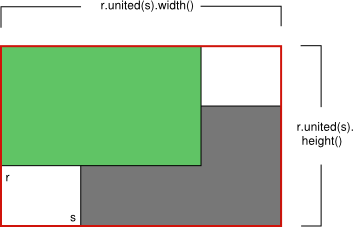
See also
- PySide6.QtCore.QRect.width()¶
- Return type
int
Returns the width of the rectangle.
See also
- PySide6.QtCore.QRect.x()¶
- Return type
int
Returns the x-coordinate of the rectangle’s left edge. Equivalent to left() .
- PySide6.QtCore.QRect.y()¶
- Return type
int
Returns the y-coordinate of the rectangle’s top edge. Equivalent to top() .
© 2022 The Qt Company Ltd. Documentation contributions included herein are the copyrights of their respective owners. The documentation provided herein is licensed under the terms of the GNU Free Documentation License version 1.3 as published by the Free Software Foundation. Qt and respective logos are trademarks of The Qt Company Ltd. in Finland and/or other countries worldwide. All other trademarks are property of their respective owners.


